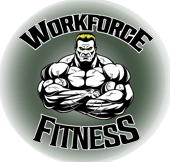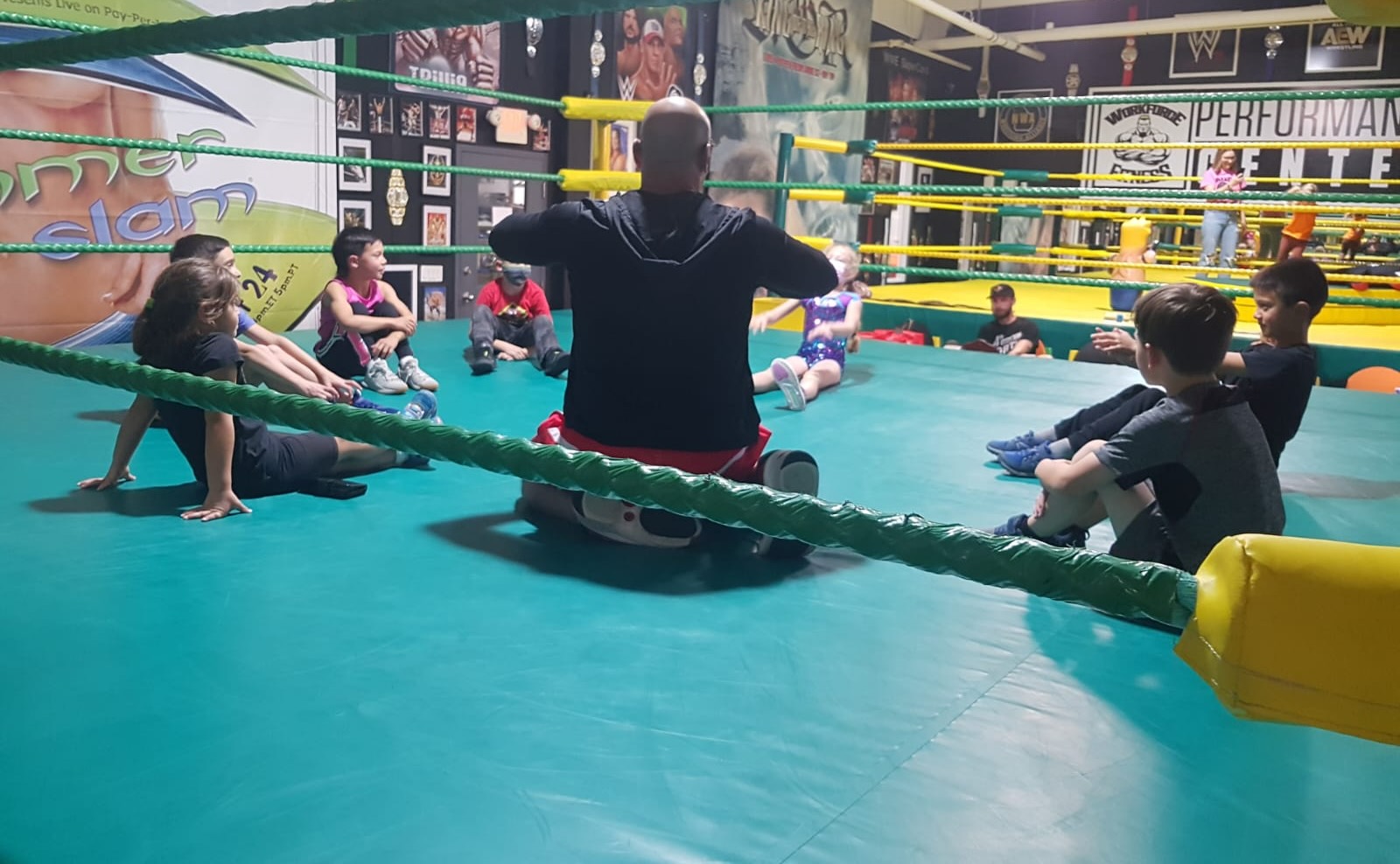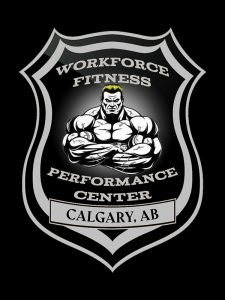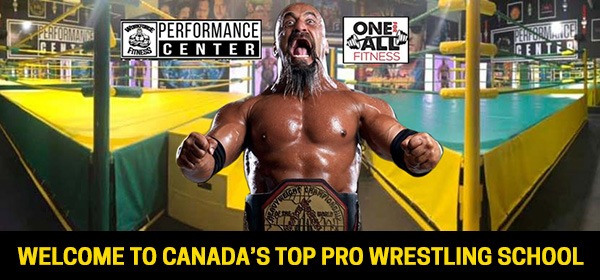Storytelling Through Creative Movement Program
Introducing The Most Exciting, Revolutionary Program For School-Aged Students That Has Been Created To Date.
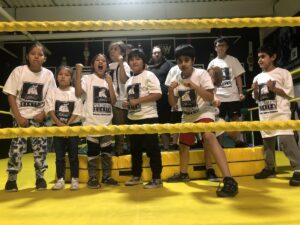 Our Storytelling Through Creative Movement Program was developed thanks to a request made to the Workforce Fitness Performance Center (WFPC) by a private school to help find an alternative to dance and gymnastics programs, where students were not expressing much interest. When students were asked, they expressed a greater interest in Professional Wrestling. With safety in mind, we created a purpose-driven and structured athletics program that met the board of education’s guidelines, such as not inverting students or performing any activity or movement that had the potential for injury yet still captures the student’s interests and imagination.
Our Storytelling Through Creative Movement Program was developed thanks to a request made to the Workforce Fitness Performance Center (WFPC) by a private school to help find an alternative to dance and gymnastics programs, where students were not expressing much interest. When students were asked, they expressed a greater interest in Professional Wrestling. With safety in mind, we created a purpose-driven and structured athletics program that met the board of education’s guidelines, such as not inverting students or performing any activity or movement that had the potential for injury yet still captures the student’s interests and imagination.
Our Storytelling Through Creative Movement Program is the first of its kind to be delivered on and off campus to private schools in and around Calgary.
At the WFPC we explore different elements of storytelling through creative movement by providing youth with the opportunity to physically participate in our program, enhancing students’ creativity, interest and attention span. By acting out stories through personal expression and critical thinking, youth will have the opportunity to consider how characters look, move, sound and develop the gestures and voices that make characters come to life. (e.g., character development, setting, pantomime, dramatic structure and psychology).
Our mission is to embrace students’ differences by ensuring they are treated with dignity and respect. By encouraging our youth with different beliefs, spiritual backgrounds, and diversity we give them the ability to communicate and express their character, identity, feelings and understanding of who they are through physical storytelling within a safe, integrated, tailored, high-performance, inclusive and respectful environment to foster personal growth.
Our vision is to see youth progress through our program where they will have the opportunity to integrate decision making through the art of Professional Wrestling. By developing their character through role-playing as the Hero or Baby Face (e.g., the Protagonist) and the Adversary or Heel (e.g., the Antagonist) we give students the opportunity to maintain a safe and healthy environment to learn and develop new skillsets. Our curriculum stresses the development and the integration of specific theatrical and athletic skills within a co-operative learning environment that is emphasized through self-expression, flexibility, self-confidence and self-discipline.
Our Storytelling through Creative Movement Program offers youth a continuum of experiences that move well beyond the introductory and exploratory foundational skills and activities outlined. The focus of our program is a full-scale performance of a scripted skillset.
Character Development
In Professional Wrestling, character development is the craft of giving a character a personality, depth and motivation that propels them through a storyline by simply amplifying their own personality, and how a character evolves throughout the course of that storyline.
Believable characters are unique and three-dimensional and not so different from real life. Our goal is to develop their character’s growth in the face of adversity, much like young people grow and adapt to their own real-life experiences. We will help youth establish a character’s motivations and goals, choose a voice, do a slow reveal, create a struggle, give a character’s backstory, describe the character’s personality in familiar terms and paint a physical picture of that character.
Psychology
The Psychology of Professional Wrestling is essentially a performers In-Ring ability to make a performance look like a real struggle. By understanding that the onlookers live vicariously through them (e.g., the worker), fans cheer the “Baby” who outperforms the “Heel”, who then must resort to less traditional movements to outdo the “Baby”. This then creates sympathy for the “Baby”, inspiring emotion for onlookers who start to cheer and support the “Baby” to see them achieve a victory, while simultaneously hoping for the defeat of the “Heel”.
When youth start to understand this concept of storytelling and apply it in their movements, it becomes an incredibly rewarding and satisfying form of expression through audience engagement!
In Closing
Not only will your youth acquire some of the most important life affirming skills that can be developed to aid them as they grow and mature, but once they are fully trained and have honed their craft, they will be able to gain employment with major international organizations like All Elite Wrestling (AEW) and the World Wrestling Entertainment (WWE).
We believe that when one of your students has completed their training with us and gets some experience with one of our sister companies such as the Real Canadian Wrestling (RCW), or the CanAm Wrestling Federation, then secures a contract with one of the major wrestling organizations. It will propel your learning facilities’ reputation and status to heights reserved only for schools with some of the most established athletics programs in the country, such as, the Upper Canada College, Branksome Hall, Trinity College, St. George’s, and the Crescent School.
Let us work together to guide our youth to strive to reach their athletic and academic potential for years to come.
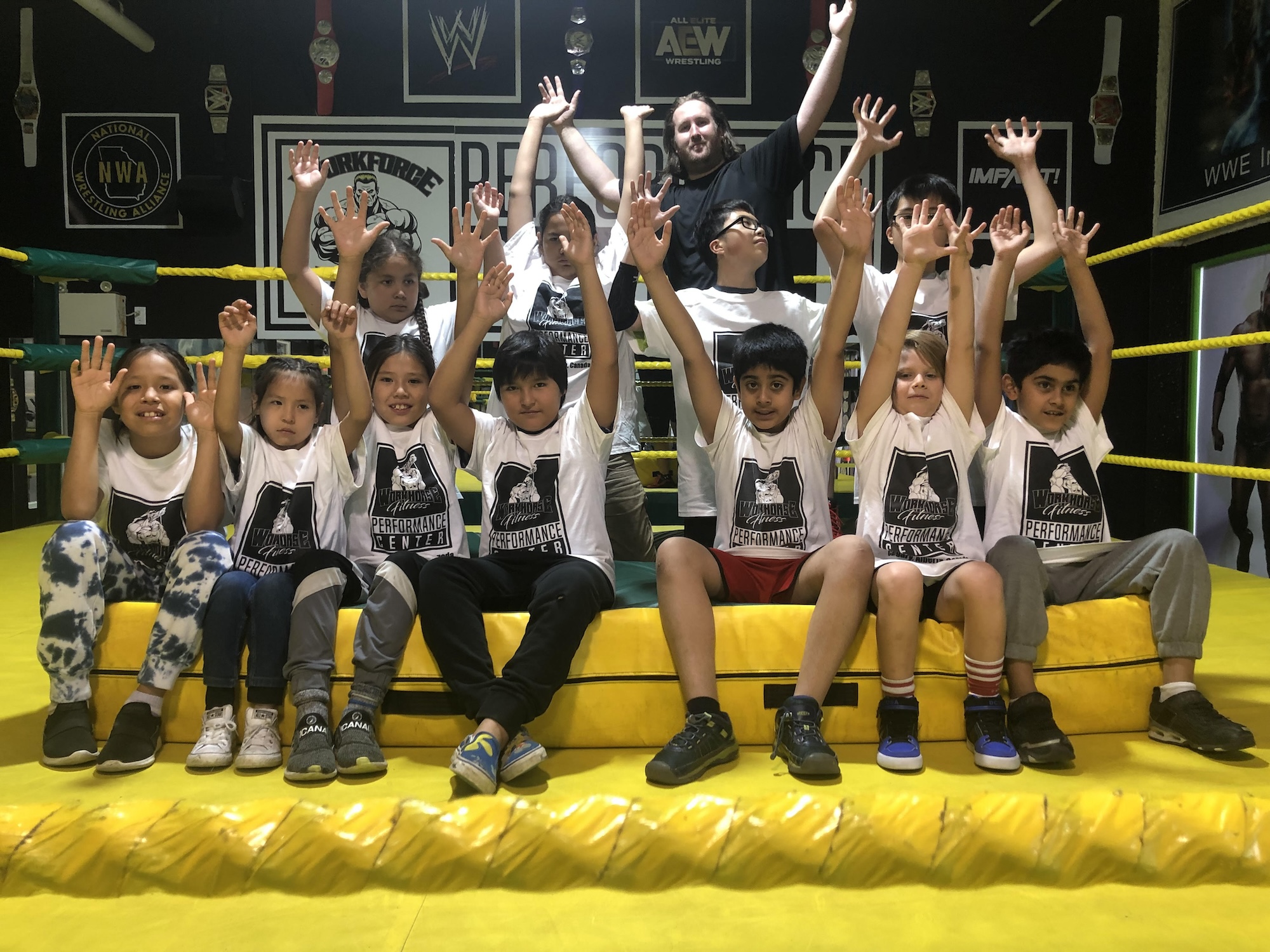
Many schools integrate our storytelling through creative movement program as part of their curriculum, and it has been seen to help develop language & literacy.
Here’s why it’s beneficial and how it’s used:
Early Literacy: Storytelling movement helps students connect stories with actions, making them easier to remember and understand.
Language Development: Movement can help express emotions and ideas, improving language skills.
Creativity & Imagination: Creative movement encourages students to explore and develop their own unique interpretations of stories.
Kinesthetic Learning: For students who learn best through movement, it’s a natural and effective way to engage with learning.
Social Skills: Sharing stories and responding to others through movement can foster social interaction and communication skills.
Examples of how it’s used:
Grades 1 to 12: Students might explore a story through pro wrestling for acting out scenes.
Art Programs: Creative movement can be used to inspire projects based on stories.
Artist-in-Residence Programs: Organizations often bring in athletes such as Pro Wrestlers who use movement to teach various subjects.
In summary, storytelling through creative movement is a common and effective pedagogical approach and many schools are now incorporating our program it into their curriculum! 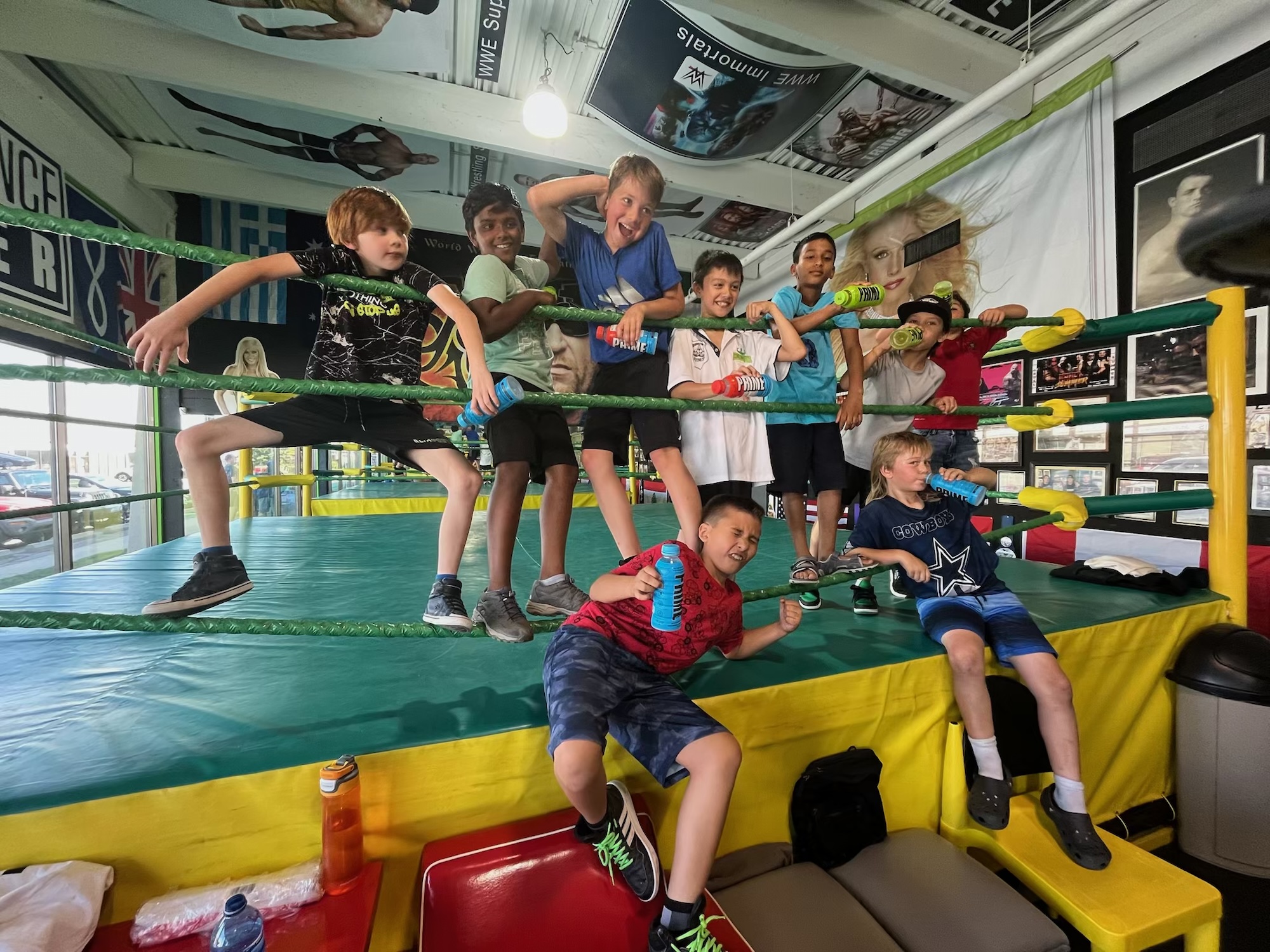
Expectation For Coaches Behavior
PRINCIPLE 1 – Confidentiality & Privacy
We . . .
- Share information appropriately (teachers, students, parents, etc.) and as needed to ensure the smooth operation of the Workforce Fitness Performance Center (WFPC).
- Are entitled to expect confidentiality when providing personal information of any kind.
- Maintain the security of WFPC files, student records and personal information (locked – WFPC, working files for coaches only).
PRINCIPLE 2 – Respect for Work Relationships
We . . .
- Treat each other, as well as, students, parents, community members with dignity, respect and consideration.
- Conduct our responsibilities as outlined in our contracts with trust and integrity.
- Maintain a safe and caring work environment to conduct our duties.
- Maintain a clean, safe workspace.
- Care for ourselves by being aware of our own stress levels and taking steps to stay healthy, fit and ready for work.
- Report any mental health or medical issues that may impair our ability to perform our training duties to our athletics director.
- Do not engage in relationships that will disrupt the WFPC community or workplace.
- Do not expose students to sexual contact, activity, behavior or material.
PRINCIPLE 3 – Respect for Boundaries
We . . .
- Appreciate each other’s areas of expertise and roles and do not overstep boundaries.
- Take care to ensure that our communication is professional.
- Are respectful of each other’s time and space. We try to minimize interruptions such as social chatting, social media and non-school matters during school hours.
- Do not engage in discriminatory, harassing or inappropriate behavior that may compromise the WFPC’s image or reputation.
- Respect personal time by refraining from contacting teachers during off hours unless it is of an urgent nature regarding training matters.
- Do not use information gained through school matters to gain benefit (financial or otherwise) either directly or indirectly.
PRINCIPLE 4 – Respect for Laws
We . . .
- Adhere to the WFPC’s mission statement, policies, practices and procedures at all times.
- Adhere to the laws, regulations and standards in the School Act, Guide to Education, Professional practice standards, and Teaching Quality Standard.
- Comply with and be aware of legal and government requirements, including PIPA Personal Information Protection Act or relevant sections of FOIP Freedom of Information and Protection of Privacy Act, at all times.
- May use WFPC property and space provided the proper permission has been gained and paperwork completed. We exercise reasonable care to prevent abuse, excessive wear, loss or damage to WFPC equipment or property.
- Notify our athletics director immediately of any circumstance (personal or work-related) that may negatively impact the image, reputation of operation of the WFPC.
PRINCIPLE 5 – Respect for Individuality
We . . .
- Honor and celebrate our unique skills, abilities and preferences so long as they do not harm or interfere with another coach, student, parent or staff member.
- Respect the differences in our personal relationships, the celebration of holidays, etc. by encouraging an understanding of other cultures, customs and beliefs.
- Work together to create a safe and caring learning and working environment for all!
Consequences For Breaching the WFPC Code Of Conduct
Consequences for Breaching the WFPC Code of Conduct will be determined by the Athletics Director. Discipline measures and procedures are outlined in the WFPC Discipline Policy.
Coaches
We feel there are three key aspects to coaching staff. They are growth, supervision and evaluation.
Growth – means a career-long learning process whereby coaches annually develop and implements a plan to achieve professional learning objectives or goals that are consistent with personal assessment of learning needs, the WFPC’s expectations and the Teaching Quality Standard. All coaches employed by the WFPC must complete an annual growth plan. The plan is reviewed with the athletics director in June.
Supervision – Is an ongoing process by which the athletics director provides support and guidance to coaches. It involves observing and receiving information from a variety of sources about the quality of work undertaken by the coach. When the athletics director has reason to believe that a coach’s behavior, knowledge or skills may not meet the standard, they will work with the coach directly, through supervision, to provide assistance to change behaviors or practices.
Evaluation – Evaluation is the formal process of gathering information over the school year to determine whether a coach meets expectations related to employment or practice. At the WFPC this is done in June and may be combined with a review of the growth plan. When an evaluation determines that expectations are not being met, it may be appropriate to offer a period of remediation or change of tasks and duties or recommend the termination of the coach.
About the Program Director
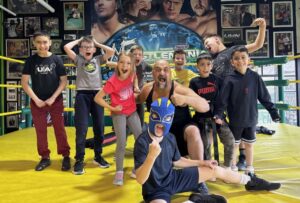 Ali Farhat is the Workforce Fitness Performance Center’s Athletics Program Director and Health & Safety Director. His responsibilities include developing and overseeing the Storytelling Through Creative Movements Program which they deliver exclusively to private schools, He is also responsible for the implementation of their Health & Safety Management System.
Ali Farhat is the Workforce Fitness Performance Center’s Athletics Program Director and Health & Safety Director. His responsibilities include developing and overseeing the Storytelling Through Creative Movements Program which they deliver exclusively to private schools, He is also responsible for the implementation of their Health & Safety Management System.
Ali is better known as The Beast From The Middle East, The Man They Hale Ali. He has been a Professional Wrestler and a Health & Safety Professional for over 20 years. He has overseen the Canadian Blood Services Health and Safety Division in Calgary and Saskatchewan, as well as Saudi Arabia for Saudi Aramco’s Northern Area Oil Drilling Department as the Lead Safety Compliance Coordinator. It has been his delight to have been able to work all over Alberta, Saskatchewan and B.C. in the Oil Sands Industry, mentoring, coaching and leading Canadian workers.
Simultaneously, he has had the pleasure of leading the coaching teams of young adults at Performance Centers on the TsuuT’ina Nation as the Athletics Program Director for the Ultimate Wrestling Nation (UWN). He then launched the WFPC’s second Performance Center in Dubai UAE the UWN Dubai. Ali has now been the Athletics Director and Health & Safety Director at the Workforce Fitness Performance Center here in Calgary since 2019.
